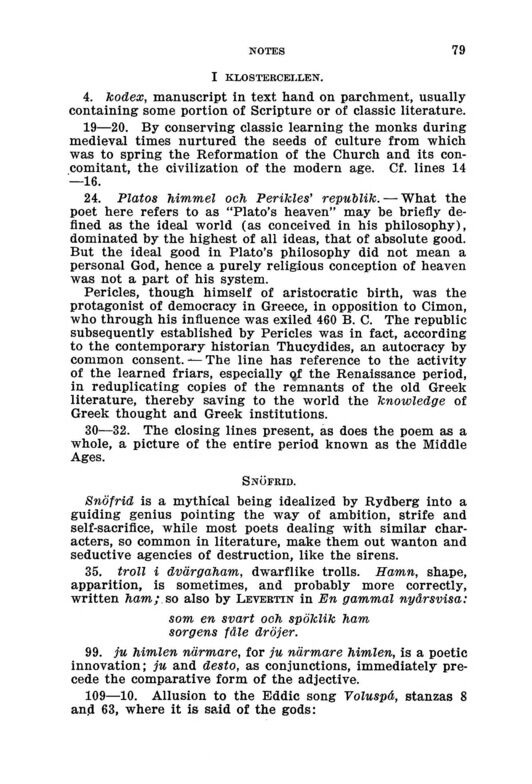
Full resolution (JPEG) - On this page / på denna sida - Sidor ...

<< prev. page << föreg. sida << >> nästa sida >> next page >>
Below is the raw OCR text
from the above scanned image.
Do you see an error? Proofread the page now!
Här nedan syns maskintolkade texten från faksimilbilden ovan.
Ser du något fel? Korrekturläs sidan nu!
This page has never been proofread. / Denna sida har aldrig korrekturlästs.
NOTES 79
I KLOSTERCELLEN.
4, kodex, manuscript in text hand on parchment, usually
containing some portion of Scripture or of classic literature.
19—20. By conserving classic learning the monks during
medieval times nurtured the seeds of culture from which
was to spring the Reformation of the Church and its con-
.comitant, the civilization of the modern age. Cf. lines 14
—16.
24. Platos himmel och Perikles’ republik. — What the
poet here refers to as “Plato’s heaven” may be briefly
defined as the ideal world (as conceived in his philosophy),
dominated by the highest of all ideas, that of absolute good.
But the ideal good in Plato’s philosophy did not mean a
personal God, hence a purely religious conception of heaven
was not a part of his system.
Pericles, though himself of aristocratic birth, was the
protagonist of democracy in Greece, in opposition to Cimon,
who through his influence was exiled 460 B. C. The republic
subsequently established by Pericles was in fact, according
to the contemporary historian Thucydides, an autocracy by
common consent. -— The line has reference to the activity
of the learned friars, especially of the Renaissance period,
in reduplicating copies of the remnants of the old Greek
literature, thereby saving to the world the knowledge of
Greek thought and Greek institutions.
30—382. The closing lines present, as does the poem as a
whole, a picture of the entire period known as the Middle
Ages.
SNÖFRID.
Snöfrid is a mythical being idealized by Rydberg into a
guiding genius pointing the way of ambition, strife and
self-sacrifice, while most poets dealing with similar
characters, so common in literature, make them out wanton and
seductive agencies of destruction, like the sirens.
35. troll i dvärgaham, dwarflike trolls. Hamn, shape,
apparition, is sometimes, and probably more correctly,
written ham; so also by LEVERTIN in En gammal nyårsvisa:
som en svart och spölklik ham
sorgens fåle dröjer.
99. ju himlen närmare, for ju närmare himlen, is a poetic
innovation; ju and desto, as conjunctions, immediately
precede the comparative form of the adjective.
109—10. Allusion to the Eddic song Voluspå, stanzas 8
and 63, where it is said of the gods:
<< prev. page << föreg. sida << >> nästa sida >> next page >>